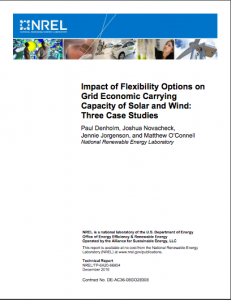Full Title: Impact of Flexibility Options on Grid Economic Carrying Capacity of Solar and Wind: Three Case Studies
Author(s): Paul Denholm, Joshua Novacheck, Jennie Jorgenson, and Matthew O’Connell
Publisher(s): National Renewable Energy Laboratory
Publication Date: December 1, 2016
Full Text: Download Resource
Description (excerpt):
In this study, we attempt to quantify the benefits of various options for improving grid flexibility by measuring their impact on two measures: economic carrying capacity and system costs.
The first measure—economic carrying capacity (ECC)—determines the level of penetration of variable-generation RE at which the costs outweigh the benefits and where additional VG is no longer economically desirable. In all cases, we define penetration as the fraction of annual electricity demand met by RE. Fundamentally, an ECC results from the decline in value of renewables as they are added to the grid. Increased flexibility can increase the value of RE, and therefore, can also increase the ECC.
The concept of ECC, particularly when applied to VG, has evolved over time. Historically, physical or technical issues have been perceived to fundamentally limit the penetration of VG. However, a more nuanced understanding has been gained through grid integration studies and operational experience. Specifically, there is growing recognition that although technical challenges to integrating VG are real, they can generally be addressed by a variety of solutions already available—each one having an associated implementation cost. As a result, the limit of RE penetration is primarily economic, driven by factors that include transmission availability and operational flexibility.
The second measure looks at the reduction of system costs. Quantifying this measure includes determining the reduction in operating costs resulting from increased operational efficiency, as well as reduction in capital costs if the flexibility measure reduces the need for conventional capacity. (The operational value of VG represents its ability to offset the variable costs of operating a power system, including fuel costs, variable operations and maintenance costs, and emissions costs. The capacity value of VG represents its ability to offset the need for conventional capacity, driven by the coincidence of electricity demand with VG output.) A cost-benefit analysis can then be made by comparing this reduction in costs to the implementation costs.
Specific goals of our study are to examine the following:
- The operational and capacity value of VG as a function of penetration using a grid simulation tool, comparing this value to its cost. In our analysis, we use PLEXOS, a production cost model.
- Drivers behind limited ECC, including increasing levels of curtailment and decreasing capacity value of VG.
- The impact of grid flexibility options on ECC.
- The net cost savings from different flexibility options.
From the analysis, results, and conclusions of this report, system operators and planners can better understand how best to use flexibility options to accommodate greater amounts of RE on the grid across different regions and conditions.
